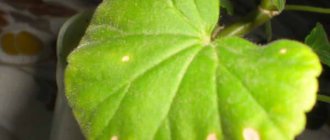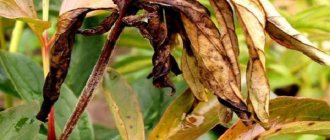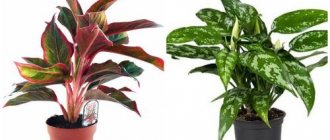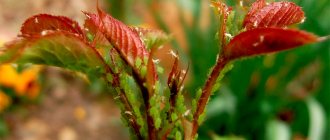Azaleas (or, as they are also called, rhododendrons) are flowering plants grown at home and in the open ground. Potted evergreen shrubs require maintenance in certain conditions - cool air and high humidity. They are sensitive to soil composition, lighting and watering. Violation of agrotechnical recommendations leads to weakening of the plant. An azalea with reduced immunity is defenseless against diseases and pests. From the article you will learn about the ailments of rhododendron (such as brown stems and roots, falling leaves, etc.), see their photos, and become familiar with methods of treating diseases and controlling pests.
What can indoor rhododendron suffer from?
Plant diseases are negative conditions caused by viruses, bacteria, fungi or improper care. Azaleas react to a lack and excess of nutrients and the degree of soil moisture. Characteristic symptoms:
- drying of leaves and buds;
- discoloration, appearance of spots;
- falling leaves and flowers;
- root rotting;
- growth retardation.
Pests are insects that have settled on a plant. Phytophages feed on azalea sap, causing wilting, yellowing of leaves and deformation of buds. One of the dangers is the spread of viruses and fungal infections by pests.
Causes
Finding the cause of a plant’s deterioration begins with examining its soil.
After checking the soil for the presence of insect pests, inspect the leaves and stems. In the absence of parasites, symptoms and previous agricultural management are analyzed to diagnose the disease.
The condition of an azalea can worsen even if the recommended watering regime , daylight hours, and temperature are violated.
How to determine the cause of the disease?
If you notice a deterioration in the condition of a houseplant, you should carefully examine it and the soil in the pot. If small phytophagous pests are found, then you need to fight them. Usually insects are found on greenhouse and garden specimens, but they also get into the house without problems. In other cases, agrotechnical care is reviewed and the symptoms of the disease are studied.
To establish the cause of the disease, you must:
- Take into account all agrotechnical factors:
- watering frequency;
- soil composition;
- feeding;
- temperature;
- humidity level;
- illumination
Deviations from the norms recommended for azaleas lead to a deterioration in the condition of the plant.
- Study the signs of fungal infections and the effects of pests, compare them with the condition of the plant.
Prevention and protection of plants
To prevent the development of diseases dangerous to azaleas and the invasion of harmful insects, you should adhere to the following recommendations:
- The flowering shrub should be placed in a bright place, but protected from direct sunlight.
- Water the plant with boiled or melt water.
- Do not overdo it with soil moisture.
- Maintain air temperature in the range of 12-15 degrees.
- It is necessary to feed azaleas in the summer with ammonium sulfate, and in the winter with superphosphate.
- Timely pruning and pinching allows the plant not to waste its energy.
- To replant a bush, use only disinfected soil, containers and tools.
Growing azaleas is a rather complex process that requires knowledge of all the intricacies of planting and care features. If you adhere to the correct agricultural techniques, then the risk of infection of evergreen shrubs with fungal diseases and pests is reduced to zero. Only a favorable indoor microclimate and compliance with all recommendations for azalea maintenance can achieve the desired results.
Treatment methods at home
Treatment of diseases is an integral part of flower care. Most problems can be eliminated by establishing optimal conditions. In the fight against infections and viruses, special drugs will be required. Common azalea problems include the following.
Drying of the bush
The main reasons causing azaleas to dry out:
In the first case, it is recommended to increase the volume of water during irrigation. The soil must be moistened after the top layer has dried. If a lump of earth is too dry, water does not stay in it. To saturate the plant with moisture, the pot is lowered into a container of water for 15-20 minutes.
Azalea prefers cool weather; in the heat, it loses leaf turgor and withers. In summer, the plant is kept at a temperature no higher than 20-22°, and in winter – 15-16°. For azaleas, you should find a place away from heating devices.
An evergreen plant requires timely watering and moist air. During the operation of heating devices, the problem of dry air is solved by additional humidification. The pot with the azalea is placed on a tray with wet expanded clay or pebbles.
You will find more information about why azalea leaves dry and what to do in this case in a separate article.
Yellowing of the crown
Changes in leaf color occur when the soil is depleted and the content of calcium salts is high. Using hard water for irrigation changes the acidity of the soil. In alkaline and neutral soil, azalea does not absorb iron and magnesium well. The result is chlorosis. For treatment, it is necessary to water the plant with acidified water (3 drops of lemon per 1 liter of water) and apply mineral fertilizers for the azalea.
We wrote more about why rhododendron leaves and other organs turn yellow and how to save the plant here.
Blackening of foliage
Examination of the plant and the nature of the spread of the problem will help determine the cause of the darkening of the leaves.
- Black spots on the inside of the leaf blade may indicate a black thrips infestation. The pest is destroyed with Karbofos emulsion.
- The spread of darkening to the stem is similar to the manifestation of fusarium. Watering will allow you to correct the diagnosis - deterioration of the plant’s condition confirms a fungal infection.
In case of minor damage, the bush is saved by treatment with Fundazol. At a late stage, the azalea cannot be saved. It is destroyed along with the soil to prevent the spread of the disease.
Find out what to do if the leaves of an azalea turn black and fall off in our article.
Shedding of leaves and buds
Leaf loss is a common problem with recently purchased azaleas. They suffer from a lack of nutrients in the soil and changing climatic conditions. To save the plant, the following actions are recommended:
- Transfer the bush into a pot of larger diameter and fill the free space with soil for azaleas.
- Spray the plant with a growth stimulator - Novosil or Epin.
- Place the bush under a plastic film that provides high humidity and a stable microclimate.
- Ventilate the plant daily.
Indoor azalea - diseases
Indoor azalea is susceptible to the following types of disease: wrinkled or falling leaves - insufficient watering, insufficient air humidity, location under bright sunlight or too high room temperature. Short flowering period - the reasons are the same. Yellowed leaves – excessive dampness or too hard water used for watering. Poor growth, poor budding, browning of leaves and lack of flowering - unsuitable soil for planting azaleas or lack of timely fertilizing, as well as fertilization with inappropriate preparations.
Source
Insects and measures to combat them
A common cause of illness and death of azaleas is the appearance of pests:
- The rhododendron bug is a winged insect measuring 3-3.5 mm. Lays eggs on the back of leaves, covering them with resinous secretions. Adults and larvae suck the sap of the plant. The leaves turn yellow and curl. Pests are destroyed with insecticides “Decis” and “Fury”.
- Mealybug - the body of the parasite is covered with a white waxy coating. It affects all parts of the plant. The secretions of scale insects contribute to the spread of sooty fungi. Control measure: treatment with Actellik.
- Weevil - adult beetles eat the edges of leaves, buds and buds. The larvae in the soil damage the roots. The following products are used against weevils: “Bazudin”, “Aktara”.
- Beetleworm - a beetle that eats leaves, leaving only the veins. The remedy is Diazinon.
- Slug - feeds at night on young plants, eating the rudiments of leaves. Insects are collected using traps and Mesurol is used.
- Thrips – Greenhouse or black thrips eat azalea leaves. Due to damage they turn yellow and fall off. Insects are removed with a solution of Karbofos.
- Moth – The pest of the bush is the caterpillars of the azalea moth. They feed and pupate on leaves. Fumigation and spraying with sulfur are used against the pest.
- Fly - rhododendron fly is a specific pest that sucks sap from leaves. It gets rid of it with nicotine sulfate.
- Aphids are small insects that live in colonies. Their vital activity slows down the growth of bushes and leads to a delay in flowering. Aphids carry viruses. Karbofos and Actellik are used in pest control.
- The whitefly is a butterfly that sucks the juice of azaleas. The plant is stunted, withers and dies. The bushes are washed with soapy water and sprayed with Aktara.
- Mite - 3 types of mites parasitize azaleas - red, strawberry and spider mites. Adults and larvae damage the tops of shoots, flowers, and leaves. Pests hide on the underside of leaves, making detection difficult. Actellik is used to kill ticks.
Watch a video about what pests affect azaleas and how to deal with them.
Below you can see photos of common azalea diseases and pests.
Major pests
Not only diseases, but also parasitic individuals oppress azalea. Evergreen bushes can be affected by:
- Rhododendron bug , which grows to only 3.5 mm in length, lays its offspring on the inside of the leaf, protecting them with resinous secretions.
- Mealybug , which has a white waxy coating on its body. Its secretions are an excellent breeding ground for sooty fungus.
- Weevil , the larvae of which are found in the ground. Adults prey on azalea leaves, buds and buds.
- Khrushchik attacking leaf blades.
- Slug , which poses a threat to the primordia of leaves of flowering shrubs.
- Thrips (greenhouse, black). The pest eats the leaves, which first begin to turn yellow and then fall off.
- I pray . Caterpillars that feed on leaves and pupate inside them are especially dangerous for azaleas.
- Fly . The harmful insect feeds on the sap of leaf blades, which provokes weakening of the azalea and its subsequent death if diseased specimens are not treated with appropriate medications.
- Aphids . The small insect lives in colonies and is a source of viral diseases.
- Whitefly . Due to the fact that the butterfly sucks the juice from the plant, it noticeably lags behind in growth, withers and dies.
- With a tick . Red mites, spider mites, and strawberry mites can also infect azaleas. First of all, the upper part of the shoots, leaf mass and flowers suffer from this pest. The mite lives on the inside of the leaf, which complicates the process of detecting it.
If you do not take any action at the first sign of identifying diseases and harmful insects, you may waste time and lose your exotic plant.
Further care
Basic recommendations for flower care are as follows:
- The shrub requires good lighting, but without direct sunlight.
- It is recommended to fertilize in summer and autumn, before setting buds. It is better to reduce the fertilizer concentration by 1.5 times.
- Water only with soft water - melted or boiled, and acidify with lemon once a week.
- Avoid drafts and sudden changes in temperature.
- Dry air is detrimental to the plant.
- At temperatures below 15°, azalea is not sprayed.
There are enough modern drugs to combat diseases and pests of ornamental plants. But it is more important to provide the flowers with optimal conditions under which problems will not arise. Caring for azaleas is not easy, but the abundant and long-lasting flowering of the bushes will be a worthy reward for your efforts.
If you find an error, please select a piece of text and press Ctrl+Enter.
Diseases and pests in azaleas will appear due to the lack of high-quality drainage, excess moisture in the soil, and sudden changes in temperature.
Azalea care
Azalea is considered a capricious indoor plant, but with proper care there will be no problems, and the aristocrat will delight you with an abundance of luxurious flowers.
Azalea in a pot
When purchasing an indoor flower, you must understand whether your conditions: lighting, temperature, air humidity correspond to the natural environment in which this sissy grows. It is important to study the features of caring for azaleas.
Selecting soil for planting
Soil for flowers
- The indoor plant prefers soil with an acidity of pH 4-4.5.
- For planting, you can take heather soil or make a mixture of peat and coniferous soil in a 1:2 ratio. It is advisable to add coarse river sand when compiling the soil.
Another growing method is hydroponics. Specialized stores sell ready-made soils for acidophilic (those who like “sour” things) plants.
When planting plants in purchased soil, it is important to ensure that it does not dry out, but also does not cake from moisture, otherwise the soil will sour and sooty fungus will develop. To ensure breathability of the soil, it is necessary to add perlite, but in no case moss.
Lighting
Azalea prefers bright light, but exposure to sunlight on the leaves causes burns, the vegetative parts turn yellow, dry out and fall off, so the lighting should be bright but diffused.
In winter, azaleas should be placed on a windowsill on the south side, in summer - on the east side.
Maintaining Humidity
Requires high air humidity. Growing in a hot apartment can destroy the plant, so you can install an additional container of water near the flower pot. Daily spraying of foliage is necessary.
Spraying flowers
Under no circumstances should a pot with a plant be placed close to heating appliances.
Watering
Azalea is demanding on water quality. On the Internet you can find information that watering should be done only with distilled or rain water.
This is not entirely true:
- You can take regular tap water, boil it and cool to room temperature.
- Over time, the azalea will adapt to the composition of the water and will develop normally, and you will not have to collect rainwater all the time.
Water hardness has a detrimental effect on plants
Azalea is no exception. Therefore, you need to spray with boiled water.
Once a week you need to water the plant with water with the addition of citric acid (1 tsp per 2 liters of water). This is necessary to maintain normal soil acidity.
Water with a solution of citric acid only after regular watering!
After each watering, it is necessary to drain the remaining water from the pan.
Azalea does not like either drying out or waterlogging of the earthen coma. With the arrival of autumn, watering is reduced and the flower is prepared for the dormant period.
Do not loosen the soil near the plant, as you can damage the delicate root system.
Some gardeners, in order to water the plant with melt water, bring snow from the street and spread it on the surface of the soil. This method is only suitable for greenhouses where azaleas are kept cool all the time.
Watering with cold water leads to loss of decorativeness and the cessation of flowering.
Transfer
It is recommended not to replant, but to transfer the plants into a larger pot. Young azaleas are replanted annually, old specimens - once every 2 years. Before removing the azalea from the pot, it is necessary to water it well so that the earthen lump does not crumble. After transshipment, a void is formed, which is filled with fresh substrate.
Azaleas have a shallow root system, so they grow them in a low pot.
Fertilizer application
- During the growing season, feed once a week with ammonium sulfate, superphosphate, and ammonium nitrate.
- When buds form on the plant, 15 g of superphosphate is diluted in 10 liters of water and watered.
Care during flowering
Abundant flowering depends on proper trimming of the stems and pinching the tops. Young shoots are pinched in May, leaving 4-5 leaves. You cannot leave shoots near flower buds - they need to be removed.
If the azalea grows as a lush bush, with beautiful glossy foliage, remember, flowering will be sparse!
Keeping it in a cool room will extend the flowering period.
Up to 4 buds bloom from one flower bud. As they fade, you need to remove faded flowers and seed pods so that they do not take away the strength of the azalea.
The blooming beauty can be moved from place to place. Changing the location will not affect flowering, the buds will not fall off.
Formative crown pruning
At the end of summer, flower buds appear on the tops of the shoots. Therefore, it is necessary to prune the azalea in time so that by the end of the growing season a sufficient number of apical shoots have time to form.
In other words: all shoots of the previous year are removed, as well as poorly formed, flaccid, weak ones.
Pruning an indoor flower
When pruning, closely spaced branches should be removed one to one to ensure normal development. Formative pruning allows you to get a beautiful plant with full buds and a voluminous crown.
The main types of crown when forming azaleas:
- bush-like
- tree-shaped
The bush-like form is easiest to obtain:
- when the growing cutting reaches 10 cm, you need to pinch the top of the plant itself and the tops of the side shoots
- From time to time you need to turn the pot to ensure uniform growth of branches
Forming an azalea in the form of a tree is also not difficult:
- you need to choose the strongest shoot, leave it, and remove the rest. it is important that the trunk grows evenly, so it needs support
- you can put a pencil next to it and tie a plant stem to it
- when the tree reaches the desired size, you need to pinch the top, now the growth of side shoots will begin
You can form an azalea in the shape of a ball: early varieties are pruned in late March - mid-April, late varieties - May-early June.
Reproduction
At home, to propagate azaleas, seed propagation, rooting of shoots, dividing the mother bush and cuttings are used. The most accessible method is cuttings, the most difficult is sowing seeds.
Seed propagation
To get plants from seeds, you need to put in a lot of effort and only a great desire, and knowledge of agrotechnical techniques will help you grow a flower. To sow, you need to buy high-quality seeds. Seeds germinate for a long time and reluctantly.
You need to sow in a certain soil, which is bought in specialized stores. You can make the mixture yourself. It includes turf, leaf soil and sand. You need to add a little peat.
After sowing, you need to spray the soil surface with a fine spray, cover with glass and place in a well-lit place.
For germination, seeds require a temperature of +25-+30 °C. Every day you need to ventilate the greenhouse and remove condensation.
When propagated by seeds, the plant will not repeat the maternal characteristics, that is, you will get a completely different specimen with new varietal characteristics.
Cuttings
The easiest way, but rooting may take six months. In June, you need to cut semi-lignified cuttings.
Flower cuttings
Pour a layer of drainage and coniferous soil into the planting pot. It is in the needles that the cuttings will take root. The plant stays in the ground for 3 years, and then it can be transplanted into azalea soil.
Step by step guide:
- Cuttings with 4-6 leaves are taken from a healthy mother plant. The cut is made at an oblique angle and one pair of lower leaves is removed.
- The lower leaves are shortened by half. The cut needs to be dipped in any solution to form roots.
- Bury the cuttings no more than 1-1.5 cm, so they take root better.
- To increase air humidity, you need to create a mini-greenhouse and spray the plant daily.
Why do you need to root in coniferous soil? It is the needles that can provide the plant with all the necessary substances. You can consider rooting in peat or river sand, but the survival rate is significantly reduced.
Division
A sure way to get new copies. Division is carried out in the spring. To do this, you need to water the mother bush well, remove it from the pot, inspect the roots and divide it into sections (each part should have 1-2 shoots).
Fungal infections and infections
Excessive watering, lack of drainage, and disturbed temperature conditions provoke fungal infections. Often, fungal infection occurs through the soil. If there are symptoms of fungal infections, be sure to isolate the azalea from other indoor plants. It is best to disinfect the windowsill and plant pots.
Alternaria blight
A characteristic sign of azalea Alternaria blight is the appearance of dark red spots of varying sizes and shapes. To combat this type of lesion, a solution of Bordeaux mixture is used as a fungicide.
Botrytis, gray mold or mold
Gray rot, caused by fungi of the genus Botrytis, develops on the leaves, stems and buds of azaleas. A sign of the disease are vague brown spots. Damaged plant tissues dry out in a short time. The cause may be poor air circulation in the room. As a control measure, use a soap solution and treat with insecticides.
Root rot
Late blight spreads to the stem and leaves of the azalea, which contributes to complete rotting of the plant. Signs: dying buds and curling leaves. The cause may be high humidity and high temperature. Bordeaux mixture and Fitoverm are used as a control measure in the initial stages.
Anthracnose or rust
The disease is more typical for tropical climates, since anthracnose develops at temperatures above 23°C. Characteristic signs are swellings that are red, brown or yellow. The leaves of the affected plant fall off. For treatment, spraying with preparations containing copper is recommended. For example, Bordeaux mixture.
Cercospora
With cercospora blight, angular brown spots with a dark red rim can be seen on the underside of the leaves. A gray coating forms on the upper part of the leaf blade. The leaves of the lower tiers are more affected. Treatment consists of alternate use of Ditan M-45 and Fundazol.
Powdery mildew
The main reasons for the appearance of this azalea disease are poorly circulating moist air and sudden changes in temperature. A white or reddish powdery coating forms on the affected parts. Infection begins on the lower layers of leaves and gradually spreads to the entire plant. For treatment, you can use a soda solution, as well as fungicides (dosage according to the instructions).
Sooty mushroom
It mainly affects weakened and young plants. Often the sooty fungus settles on the sticky secretion of azalea pests - whiteflies, aphids. Colonies of sooty fungus contribute to the death of the affected parts of the azalea. The leaves are covered with a dark gray coating. For prevention, regular ventilation is necessary, for treatment - a soap solution and treatment with fungicides.
Azalea diseases and their treatment
Houseplant diseases can occur for several reasons - the negative impact of microorganisms (fungi, viruses, bacteria) and improper maintenance conditions. When the disease occurs, azalea development stops and the color of the leaves changes. Spots and tissue necrosis appear. In a neglected state, leaves, buds and flowers fall off, the plant withers and dries out.
How to grow azalea without suffering from illnesses? To do this, you need to know the main diseases in order to provide your green pet with quality care in a timely manner.
Azalea root rot (late blight)
Late blight (late blight) is a dangerous fungal disease. Brown-purple spots appear on leaves or twigs, which increase in size and become darker over time. The affected areas become deformed, become moldy and rot.
Azalea root rot
The disease spreads quickly throughout the plant, so at the first sign of late blight, urgent measures must be taken.
| Fungicides for late blight and other fungal diseases | Active substance | Consumption |
| Fundazol | Benomyl (500 g/kg) | 10 gr. for 10 l. water |
| Previkur Energy | 530 g/l propamocarb and 310 g/l fosetyl | 3 ml of the drug per 2 liters. water |
| Fitosporin-M | Bacillus subtilis 26 D, 100 million cells/g | 1.5 gr. powder per 1 liter. water |
| Alirin-B | Bacillus subtilis, strain B-10 VIZR | 2 tablets per 1 liter. water |
| Abiga Peak | Copper oxychloride | 5 ml per 1 l. water |
If a disease is detected, it is necessary to remove the damaged parts of the plant by treating the cut areas with crushed activated carbon. Then transplant the plant into a new pot. You should first disinfect the new soil for the azalea (scald the pot with boiling water). After transplantation, the flower must be treated with a fungicide.
The most common causes of late blight are waterlogging, stagnation of soil in a container, and dense earthen substrate. Fungus may appear after regular use of rainwater for irrigation.
Tracheomycosis of azalea (fusarium)
The disease is caused by the Fusarium fungus. The following signs indicate its presence:
- yellowing of leaves, appearance of shapeless yellow spots;
- drying of the lower part of the stem;
- wilting of leaves;
- formation of wet putrefactive areas.
Sometimes you can see dark spots with a gray coating on the leaves and trunk of an azalea. This is the spore-bearing mycelium, which can quickly destroy the plant. Fusarium most often affects young or weakened plants. The fungus can be introduced when using soil taken from a garden or vegetable garden. Measures to combat the disease consist of transplanting the plant into a new pot, replacing the soil and treating it with fungicides. Damaged parts of the indoor flower should be removed and destroyed.
Tracheomycosis of azalea
Anthracnose azalea
The causative agents of the disease are fungi - ascomycetes. A sign of anthracnose is the appearance of dry yellowish areas on the leaves, in the center of which dark brown dots with a gray rim are noticeable. Over time, the affected areas grow, cracks and holes appear. Depressed gray-brown spots form on the trunk.
The affected plant stops growing and developing, the buds fall off. The decorative qualities of azaleas deteriorate.
Anthracnose azalea
Anthracnose actively develops on the plant with poor ventilation and too much watering. Fungal spores are easily carried by pests of indoor plants, as well as by the wind. If a disease is detected, the flower must be isolated from other indoor plants. Remove damaged parts, wash the plant under a warm shower and replant it in a new pot with a complete replacement of soil. After transplanting into purchased ready-made soil, you can not use fertilizers for azaleas for six months. Be sure to treat with any contact fungicide.
Alternaria azalea
A fungal disease causes leaf spots. Contrasting dark brown spots with clear boundaries are formed. The lesion is quite dense to the touch and covered with a fleecy coating. Over time, the affected areas increase in size and merge. The leaf dries completely. Spores of a harmful fungus are carried by wind, rain, and insects. Favorable conditions for the development of the disease are frequent changes in air temperature, high humidity and poor ventilation.
Alternaria azalea
Bordeaux mixture can be used to treat the disease. Before using the drug, you must carefully read the instructions. You can also use folk remedies - treat the plant with a solution of sulfur (60-70 grams per 10 liters of water) or potassium permanganate (2.5 grams/10 liters).
A good result is shown by treating the damaged plant with a solution of soda ash. To prepare it you will need 50 grams. soda and 40 gr. laundry soap. The ingredients should be dissolved in 10 liters. warm water. It is recommended to grate the soap.
Azaleas downy mildew (downy mildew)
This type of disease often appears at high air humidity in insufficiently ventilated areas. Yellow spots appear on the upper side of azalea leaves, which become darker in color over time. From the lower part you can see a light gray coating. The affected areas gradually dry out and become deformed.
Downy mildew is a complex disease. To get rid of the disease, it is necessary to treat the leaves with preparations containing copper and sulfur. Fungicides “Skor” and “Topaz” show high efficiency. When growing azaleas from seeds at home, it is necessary to process the seed.
Cercospora
A fungal disease is expressed in the appearance of numerous dark spots of small diameter on the leaves of the plant. If the problem is not identified and eliminated in time, the spots will grow and necrosis will form. The leaf dries up and falls off.
To prevent the disease, it is necessary to ensure the correct conditions for keeping the plant. Avoid sudden changes in temperature and waterlogging of the soil. Fungicides should be used for treatment. The drugs show the greatest effectiveness in the first two weeks after the formation of lesions.
Insects - pests and how to deal with them
Most often, symptoms of azalea damage appear in the form of poor growth, lack of flowering, and spots on the leaves. Some insect pests carry fungal infections.
Important! When using chemicals to control pests, carefully read the instructions for use.
Spider mite
Excessively dry air can cause spider mites to appear where leaves attach. A characteristic feature is a cobweb. The mite especially prefers the Sims azalea. Treatment: at the initial stage, use a warm shower, followed by a soap solution or garlic infusion. In case of severe damage - acaricides.
Mole
Azaleas have a specific pest - the azalea moth, a sign of which is drying of the leaves. The pest forms cocoons on the underside of leaves, continuing reproduction. Treatment: fumigation of azalea with sulfur vapor. Rogor solution is also used for destruction.
Mealybug
The main signs of the appearance of the pest are the formation of a light cotton wool-like waxy coating and sugary discharge. Treatment: eliminating traces of scale insects with a damp sponge with garlic tincture and soap or onion juice. In case of severe damage, Inta-vir or malathion will come to the rescue.
Rhododendron bug
Dark brown excrement on the bottom of the leaves is a sign of bedbug activity. Affected leaves curl and dry out. The pest reproduces in dry weather under the influence of the sun. The mode of distribution is the substrate soil, for example, heather soil. Treatment: use of insecticides Bi-58, kinmiks, malathion, decis.
Aphid
Due to aphid infestation, azalea leaves curl and lose their healthy appearance. The vital activity of aphid colonies slows down the growth and flowering of the plant, because damaged buds do not bloom. The most likely period of infection is from January to June. Treatment: spraying with karbofos, fitoverm or actellik is recommended.
Thrips
Greenhouse or black thrips eat azalea leaves, leaving characteristic holes. Due to damage, the leaves first become dull and then turn yellow and fall off. The development and flowering of azaleas slows down. Treatment: to combat insects, use a 0.3% nicotine solution or a 0.2% malathion emulsion.
Scale insect and false scale insect
A characteristic sign of the pest is yellow or brown spots along the veins of the leaves. False scale insects secrete a liquid secretion. The difficulty of treatment lies in the wax shield that protects pests from chemicals. A combined method of control is required: mechanical cleaning and treatment with actara.
Azalea pests and ways to get rid of them
Houseplant pests love the beautiful azalea. If they are not destroyed in time, they can cause significant harm to the flower. Insects enter the room through open windows and doors. They can be introduced along with a new, already infected plant. Pests often live in soil taken from a forest or garden. There are quite a few ways for aggressors to enter a closed space.
Hairy louse (mealybug)
The most common dangerous insect. Quite large (up to 5 mm), visible to the naked eye. The body of the mealybug is covered with a white or creamy powdery coating. It feeds on plant sap. Lives in colonies. An azalea pest can be easily identified by examining the leaves. In places where insects accumulate there is a sticky sweet liquid (honeydew). A dangerous infection, sooty fungus, can multiply in its environment.
Mealybug
There is also another type of hairy louse - the root mealybug, which lives underground. It is quite difficult to recognize him. To do this, you need to remove the plant from the pot and carefully examine the root. Chemical preparations for controlling these pests are “Tanrek”, “Aktara”, “Konfidor”.
Thrips
The pest has an oblong body and an elongated abdomen. Reach 2 mm in length. Adults have narrow wings and move easily through the air. They feed on plant sap. Insects are difficult to notice because they are small. But their presence should be suspected if the azalea begins to wither and lag behind in development.
If you carefully examine the leaves, you will notice an accumulation of larval excrement. Other signs of the presence of a pest are yellow and colorless spots, silvery streaks on the leaves, and underdeveloped buds. Effective chemical preparations for thrips: “Aktara”, “Fitoverm”, “Iskra-M”. Folk remedies - a decoction of onion peels, an infusion of garlic or tomato leaves.
Thrips
Mite
The pest attacks the tops of shoots, buds, and flowers. Young leaves begin to bend in the shape of a boat. The plant stops developing and the flowers stop opening. Ticks can be of the following types - strawberry, spider, red.
Spider mite
To combat them, insecticides such as Actellik and Neoron are used. The easiest way to identify spider mites. In its habitats, cobwebs are visible on the branches. If there is a slight infestation of this pest, the plant can be washed with a warm shower, and then the leaves and trunk can be wiped with soapy water.
Aphid
An aggressive insect parasitizes azaleas in large colonies. As a result, the plant begins to wither. Leaves curl, flowering is delayed or stopped altogether. Decorative qualities are lost. Aphids are carriers of infectious and fungal diseases. To combat this dangerous enemy, drugs such as Ambush, Karbofos, and Actellik are used.
Azalea moth
Particularly dangerous are moth caterpillars that damage leaf parenchyma. As a result, the leaves dry out, crumble and fall off. Adult caterpillars select healthy leaves, roll them into tubes and pupate there. You can get rid of pests by spraying the damaged plant with sulfur.
Azalea moth
Other azalea problems
A weakened state due to illness or improper care can lead to a number of other problems.
Yellowing of the crown
An excess of nutrients is just as harmful as a deficiency. The main cause of crown yellowing is excessive calcium. Because of this, magnesium starvation develops, similar to chlorosis (lack of iron). Use soft acidified water for irrigation, adding citric, ascorbic or oxalic acid.
Shedding of buds
The fall of azalea buds, in most cases, is caused by temperature changes or changes in climatic conditions. The reasons may be insufficiently moistened soil, replanting during the flowering period, or a change in light intensity. Hard water for watering the plant also has a negative effect on flowering.
Necrosis of azalea
With a significant decrease in air temperature, the main axis of the azalea leaf dies, and on top it acquires a brownish tint, which signals the appearance of necrosis.
There are varieties of azaleas whose leaves dry out and fall off after flowering. This happens mainly in winter. In this case, we are talking about the dormant period of the plant. The flower is transferred to a cool, dark place, watering is reduced, and no fertilizing is applied. The dormant period ends with the appearance of new leaves. If the azalea has not bloomed, but its leaves are falling off, then it is necessary to reconsider the care of the plant. Therefore, we recommend choosing frost-resistant flower varieties.
Prevention of azalea diseases
Often the causes of azalea disease are a complex of violations in care. It is important to observe the temperature regime, timely watering, spraying, and also feed the azalea with organic fertilizers. For prevention, you can treat with the fungicide Copper Chloride. Fundazol is also used because it is not phytotoxic.
Hello, readers of my blog. Just imagine, my beloved Azalea, which for a long time delighted me with its lush flowers, got sick. It is my fault. I had to leave for a while, and the family took care of the flowers and, apparently, incorrectly. I scoured the Internet and realized that I’m not the only one with this problem with the flower, which means there is a need to find out what Azalea diseases are, their treatment with photos will be posted on the pages of my resource.
How to treat phylocystic azalea disease
Very often, gardeners wonder why azalea leaves turn black. The formation of ash-gray with a brown border or dark brown spots on the plant’s leaves, from which sporangial balls fall, means that the azalea is infected with phyllosticosis.
To help the flower, alternately use a 0.2% solution of Fundazol and a 0.15% solution of the drug Topsin-M, and destroy the damaged leaves;
Did you know? Getting to know azaleas can sometimes be dangerous. Its smell can cause severe headaches, and azalea leaves and shoots that get into drinking water can cause poisoning. This plant has another unusual property: if you cut a twig of an azalea and hold a lit match to it, the branch will burst into flames, as if doused with gasoline.
Fungal diseases
Infections caused by fungi include:
- Fusarium. At the same time, the leaves of the plant and the stem turn yellow and wither, and a pink coating can be found on the root collar. In this case, insecticide treatment is indispensable and it is best to use a 0.2% solution of foundationazole.
- Verticellosis. This disease can be diagnosed by darkening at the base. In this case, the plant dies very quickly, and the risk of infecting other flowers increases.
- Alternaria blight. It is characterized by brown spots of different shapes and parameters. How to save Azalea in this case? Treat with Bordeaux mixture.
- Septoria. You will recognize this disease by reddish-yellow spots with black inclusions inside. Insufficient lighting, untimely pruning, excessive air and soil humidity - all these factors can lead to the occurrence of this disease, as well as late fertilizing with nitrogen. What to do in this case? Apply fungicide.
- Late blight. This is root rot, which spreads from the roots to the leaves and buds. The first ones change color, curl and dry out, and the buds die off. To combat, increase the breathability of the soil and use fitoverm or Bordeaux mixture.
- Phyllosticosis. This disease causes dark brown or ash-gray spots with a brown rim to appear on the leaves, from which sporangial balls fall out. You can cope with the disease using a 0.2% solution of foundationazole, alternating it with a 0.15% solution of Topsin-M.
- Cercospora blight. In this case, dark brown spots with a red rim appear on the underside of the leaf, and a gray coating appears on top. Treatment consists of alternating foundationazole and dithane solution.
Common diseases
The capricious azalea is often attacked by fungal infections such as:
- Fusarium. The disease is identified by yellowed stems and leaves, and a pale pink coating on the root collar. The cause of the disease is stagnation of moisture in the soil.
- Verticillium . The disease is characterized by darkening of the main stem of the flower, which soon leads to its death. Measures to treat azalea should be taken as soon as possible.
- Alternaria blight. The disease is manifested by the presence of brown lesions, they come in different shapes and sizes.
- Septoria. The development of the disease is indicated by red-yellow spots with a black center.
- Late blight . First, rot affects the root system of the plant, and then the stem, leaf mass, and, ultimately, the azalea rots completely.
- Philosticosis . The pathogen produces brown or ash-gray spots, in the center of which there are sporangia.
- Cercospora blight. Obvious signs of the disease: white plaque on the outside of the leaf, brown-red lesions on the inside.
Cercospora
Fusarium
Septoria
Alternaria blight
Diseases arising from improper maintenance
If you, like me, are wondering why Azalea's leaves dry out and fall off, then the whole problem may be insufficient watering and high air temperature in the room. This flower is quite whimsical and immediately reacts to changes in conditions. Water the plant when the soil dries slightly from above, and in winter and summer, when the room is hot, spray it daily or even twice a day.
Improper care can cause diseases such as:
- Necrosis. With this disease, the leaves turn brown and the main vein dies. The reason is a sharp drop in temperature. To get sick, a flower only needs to be in a cold draft.
- Mixed chlorosis. The main symptom is yellow spots along the edges of the leaves. Perhaps you haven’t fed your Azalea for a long time, or you may have watered it too often and too much.
Diseases caused by errors in care
If there are disturbances in the maintenance of a flowering plant, ailments such as:
- Drying and falling leaves. This occurs due to a lack of moisture in the soil or due to the indoor microclimate being too hot. The plant especially suffers from dry air in autumn and winter; the problem begins with drying out of the tips of the leaves.
- Leaf necrosis. The natural color of the azalea leaf blades changes to brown, and the main vein completely dies. The causes of the development of the disease should be sought in low temperatures and the presence of drafts.
- Mixed chlorosis. It is identified by yellow spots on the leaves. Sources of trouble are a lack of nutrients in the soil and too much watering.
Diseases caused by pests
If you can't figure out why your Azalea is dropping its leaves, try inspecting them for the presence of insects, especially if it is growing in open ground or adjacent to flowers brought into the house from the garden on a windowsill. This flower can be affected by:
- Spider mite. You can easily understand this by the thin web covering the bottom of the leaf. Deprived of juice, they acquire a brownish-gray color and fall off. Treat the plant with agravertine or actellic. At first, washing with soapy water may help.
- Asian garden beetle. It makes holes in young leaves, and in severe cases, leaves only veins. Destroyed by diazinon.
- Furrow weevil. This pest attacks the roots, which leads to wilting and death of the plant. Use karbafos and bazodin to combat it.
- Azalea moth. This parasite curls its leaves into a tube as it prepares to pupate. As a result, they dry out and fall off, and sulfur can help in this matter.
- Greenhouse thrips. Black thrips used to be common only in greenhouses, but today they have begun to be found in open ground. The insect makes holes in the leaves, and they are gray on the back side and black on the bottom. Subsequently, they turn yellow and fall off, disfiguring the flower.
- Rhododendron bug. It is one of the main pests of Azalea. After its detrimental effect, discolored spots remain on the leaves, and the insect lays eggs on the reverse side. Destroyed by diazine.
In principle, any pests can be controlled only with the help of fungicides. If in doubt, consult with the seller and he will advise you on the most suitable drug, and then you can share your experience with me and the readers.
Remember that Azalea does not tolerate direct sunlight; it feels good at temperatures of +18–22 ᵒC in summer and +12–16 ᵒC in winter. It needs to be watered with well-settled tap water or rainwater to ensure peace for the winter.
After flowering, be sure to thin out the crown, remove faded buds, and trim elongated and weak shoots. Feed the plant in a timely manner and replant it in new soil. Only under such conditions will it delight you with green foliage and lush color. I hope that my Azalea will come to life and I will be able to revive it with the help of your advice. I'm waiting for responses. Good luck!
Frequently asked questions when growing azaleas
Fans of indoor floriculture, especially beginners, are interested in questions about how to water an azalea at home, what temperature conditions the capricious beauty needs. There are a lot of questions, since growing this plant is not easy. Especially when it comes to diseases and pests.
Azalea sheds leaves: what to do?
Improper care, violation of maintenance conditions, diseases, harmful insects - all this can cause an indoor flower to begin to shed its leaves. What should be done in this case? Provide normal conditions for plant development.
A pot that is too tight can also cause the problem. The roots of azaleas grow horizontally, so it is necessary to select a wide container for it. Transplantation should be carried out using the transshipment method. For better root survival, the plant is watered with Zircon solution. Loosening the soil around the azalea should be done with caution.
Calcareous soil has an extremely depressing effect on indoor plants. Experienced gardeners recommend periodically acidifying the soil and not using calcium fertilizers. If an azalea drops its leaves, you should check the flower for pests and diseases. Timely identification of the problem will help save your green pet from death.
Some varieties may shed their leaves in winter after flowering. Thus, the plant enters a dormant period and prepares for the next growing season. At this time, it is necessary to reduce watering and move the pot to a cool, dark place.
Azalea has dried up: how to save it?
What to do if the plant does dry out? Is it possible to revive him? It is possible if the roots remain alive. You can check this in the following way: remove the plant from the pot, shake off the soil, wash and inspect the roots. Living roots are resilient and flexible. They should be left, and all the rest should be removed by sprinkling the cut areas with crushed activated carbon.
To resuscitate the root system, the plant can be immersed for a couple of hours in a “Kornevin” solution prepared according to the instructions. Next, plant in special soil, which can be purchased at a flower shop. Dry branches should be cut off, leaving shoots of 10-15 cm. The pot with azalea is taken to a room with a temperature of +10 +12°C.
Every day, the flower must be shed with water with the addition of the preparation “Zircon” and a few drops of boric acid. The liquid should not stagnate, so it is better to place the pot on a tray with expanded clay. Watering must be carried out daily until the first leaves appear.
Azalea leaves turn black and fall off: what to do?
Black spots on the plant appear both due to improper care and when damaged by pests and diseases. It is important to promptly identify the cause and eliminate it. If the blackening of the leaves occurs as a result of the negative impact of parasitic insects, you should wash the leaves and treat the azalea with an insecticide.
In case of disease, it is necessary to remove the damaged parts of the plant and spray with a fungicide. It is recommended to use biological agents indoors. For the purpose of resuscitation, the azalea is transplanted into a new pot with a complete replacement of the soil.
It is extremely important to create optimal conditions for the normal growth and development of indoor flowers. In this case, a healthy plant with strong immunity will not be afraid of diseases and pests.
Source
How to save if the leaves have fallen?
Why does the azalea disappear (fall off): dry out and shed its leaves?
The reasons that caused the leaves to fall may be different.
What to do if the azalea has dropped (thrown off) all its leaves?
To save the plant, do not trim bare branches. If the roots are not damaged, you need to spray the crown with a solution of the drug “Elina” to restore immunity. You can create a mini-greenhouse in a pot, thereby creating conditions favorable for the plant.
Frequent ventilation and moderate watering are recommended.
After the young leaves appear, you can trim the branches.











